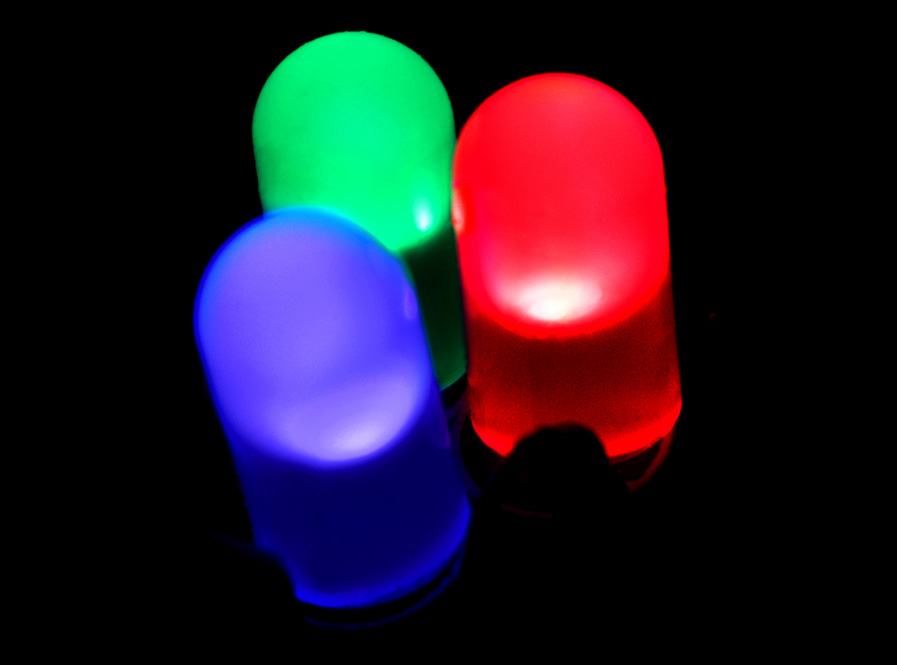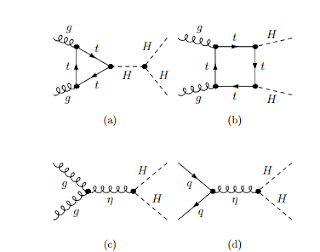Time to talk about another paper.
I've talked a lot about supersymmetry in these pages, which is somewhat ironic given that it's not been the main focus of my own research. A popular class of alternative theories involve additional spatial dimensions. I've briefly mentioned these before, but barely scratched the surface of the ideas involved.
The LED of the title refers not to the light emitting diodes pictured above, but to Large Extra Dimensions, where large is relative to typical atomic scales; I think millimetre scale extra dimensions have been ruled out, but micrometre are still experimentally plausible (but see below). These models are also sometimes called ADD models, after their inventors Arkani-Hamed, Dimopoulos and Dvali. The idea is to solve the hierarchy problem by, essentially, saying there is no problem: the scale of gravity is actually much lower than it appears to be. Equivalently, the fundamental gravitational coupling is larger than it appears.
The apparent weakness of gravity is then explained by it "leaking out" into the extra dimensions. See, on large scales the Universe appears to have three spatial dimensions. This directly leads to the Newtonian force, with the strength of gravity being proportional to the inverse square of the distance:
$F = \frac{G_N m_1 m_2}{R^2}$
Once we start probing scales below the size of the additional dimensions, this behaviour changes. For example, if we have two extra spatial dimensions then the gravitational force varies as
$F_5 = \frac{G_5 m_1 m_2}{R^4}$
The two different constants G are related, specifically by the size of the extra dimension. Up to various constants,
$G_5 \sim G_N L^2$
with L the size of the extra dimension. The true strength of gravity, $(G_5)^{1/4}$, is larger than $(G_N)^{1/2}$, because the length L is large compared to the Planck length. A more rigorous calculations shows that for two or more extra dimensions, we can lower the scale of gravity from the Planck scale to the electroweak scale without much difficulty.
At this point, you might wonder whether other forces, such as electromagnetism, would be affected by the presence of the extra dimensions. Indeed, Coulomb's law has the same $R^{-2}$ behaviour as Newtonian gravity; will it also change on short scales? The answer is yes, with a but. We have measured electromagnetism on much smaller scales than gravity, and we know that it cannot deviate till at least sub-nuclear scales. This would seem to rule out this whole type of model. However, string theory offers a solution; it is possible there to confine matter particles to "surfaces" called branes. Once we do this, only gravity will notice the presence of the extra dimension and we are safe from all other possible constraints.
The standard ways to look for extra dimensions at the LHC are to look for gravitons and black holes. Gravitons are the quanta of gravity, in the same way as photons are the quanta of electromagnetism. When a graviton travels in the extra dimension, it appears to us in the 4D world to have a large mass, and decays generally promptly to ordinary stuff. This means that for practical purposes it behaves like a new heavy particle, something we know how to look for. Black hole searches rely on the higher strength of gravity at short scales making them easier to form; they decay via Hawking radiation into a huge number of particles, leaving a spectacular signal. Both searches were among the earliest to be published (since they operate in a low-background regime) and have placed severe limits on these models.
This finally brings me to the paper I want to discuss, from a Chinese group last November. Like everyone right now, they linked their work to the Higgs; specifically, they propose an interesting way to use the Higgs to place new limits on possible extra dimensions. So far, the Higgses we have observed have been singly produced; but at some point we will need to study pair-production. pair production of Higgses is sensitive to the Higgs self-coupling, as shown in these Feynman diagrams from the paper:
The top line features the main contributions to Higgs pair-production from the Standard Model, involving gluons g fusing through loops of top quarks t. The top-left diagram involves a Higgs self-interaction (three Higgs lines meeting). This interaction is closely related to the breaking of electroweak symmetry, and it is something we want to measure to be fully confident that the object we've found is really the Higgs.
However, the bottom row shows that Higgs pair production can also involve gravitons eta. At low energies, the effect of these channels will be negligible; we don't have enough energy to produce a graviton. Obviously, at high energies this will no longer be true. Therefore large extra dimensions will change the distribution of Higgs pair production as a function of energy. Indeed, the effect can be quite dramatic:
This is for the LHC operating at design energy (14 TeV). The solid line is the Standard Model, while the dotted line includes the effect of three large extra dimensions. The vertical scale is such that 0.1 corresponds to order 10 events per year.
I think this is an interesting approach to both Higgs phenomenology, and LEDs. The only problem is that the limits that can be drawn this way, while interesting, are not fully competitive with the standard searches. The authors actually note this themselves; they compare their projected limits from a search of this kind (4 to 6 TeV) against those for lepton-based searches (6 to 12 TeV). That suggests that this work might be most useful in the event that we have a signal from one of the conventional approaches, both as a check and as a way to focus on the most relevant Higgs physics (the self-coupling).




No comments:
Post a Comment